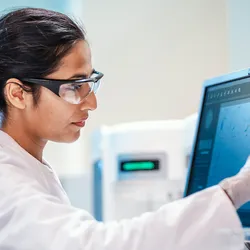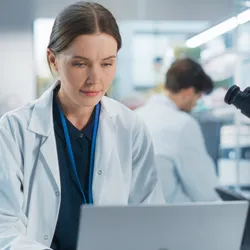Jason Boyd is the senior director for Veeva Vault LIMS strategy. He is an industry veteran with over two decades of multifaceted roles within pharmaceutical quality control. Through leading multiple global LIMS programs, building lab informatics support services, and owning lab platforms, Jason brings a honed perspective to quality control lab transformation.

Jason Boyd, senior director for Veeva Vault LIMS strategy
Credit: Jason Boyd
Q: The manufacturing lab is always evolving, yet challenges persist. What do you think is holding the lab back?
A: What’s holding the lab back right now tends to be a nondirective quality control (QC) strategy. Leaders are being held back by stagnant legacy systems - forcing them to be reactive to problems and focus on small initiatives. There is an ever-present awareness of the magnitude of effort required to change and the cost of acquired solutions. This results in a retention of older technology past its lifespan, as well as implementations of point solutions that tend to be very focused on individual problem areas, as opposed to a holistic approach.
Resources spent on point solutions that don’t integrate well within the lab end up being a pain point, preventing the overall use, value realization, and justification of the business case. All that is left in the end is redundant technology that never really finds its place in the lab.
Q: How does this impact lab execution? Are there any blind spots that should be considered?
A: During my time in the industry, there was a common concern around attracting and retaining qualified staff with a focus on new workforce entrants and their willingness to use dated technology. This created an emphasis on improving the user experience with laboratory technology. Talent retention was viewed as a key performance indicator (KPI) due to limited availability in specific regions. Ignoring the user experience when deploying technology jeopardizes labeffectiveness and efficiency, risking the ability to scale your workforce in competitive markets. At the most basic level, the consequent inefficiencies of disconnected and manual systems can retain an extra 30% or more of extra time spent on simple processes, including data entry and transcription as estimated in some business cases. This is unnecessary in the present climate of laboratory research.
Secondly, there is the concern around data accessibility and unification. Do you have access to all the data you need to make decisions? Do you have access to the procedure while you’re making data entries? Do you have access to create quality events in the quality management system (QMS) application? Are you still relying on a paper process for all of this? If so, that detracts from the efficiency of execution, creating a burden of transcription and duplicate data in different places, increased errors, and an overall drain on a culture of quality.
Q: Lab modernization efforts have long been underway. How can quality control and IT leaders truly drive transformational change?
A: It’s relevant to start with the pursuit of real-time batch release within the industry. On the manufacturing side, this is determining a ship decision for a batch within 24 hours of the longest QC task. The efficiency of your QC work can become the rate limiter. Quality control and IT leaders should pursue strategies that simplify business processes and operate nimbly. Operators should be open to this simplification while embracing technologies that reduce and eliminate surface-level and routine work.
Advanced Lab Management Certificate
The Advanced Lab Management certificate is more than training—it’s a professional advantage.
Gain critical skills and IACET-approved CEUs that make a measurable difference.
For folks implementing the change, there must be empathy for the audience they are working with, who operate in an environment of increasing level of compliance scrutiny with ever-increasing amounts of data. One cannot abruptly adopt a LIMS or supporting solution. A holistic approach that communicates the relevant business process, the simplification opportunities, and the effective deployment of new technology will always be more successful. LIMS is critical to modernizing the lab, but it is a gradual rollout that begins by simplifying workflows so that the full end-to-end process is executed. This requires a reimagining of the business in a digital landscape. It is crucial to figure this out first.
Q: You mentioned LIMS as the central piece to advance lab operations. What are the priorities when evaluating LIMS? What is a deal-breaker?
A: One of the priorities has to be a cloud-based application. As someone who spent 20 years in this industry, the ability to organize your culture around continuous releases is an important step forward to managing the nimbleness of the organization. Moving to the cloud forces a cultural shift from a keep-the-lights-on-hyper-care-managed services approach to one of continuous innovation.
This begins by taking the simplest route forward with a harmonized business process, and continuously building on it while incorporating the relevant modernization efforts required. We’re all so accustomed now to routine pushes of updates. No matter what technology you use or what team you’re on, you expect it. We ought to have that mentality when dealing with our business applications as well, and that expectation within the QC world can require a significant culture shift.
This is what we’re doing at Veeva. We have a track record of delivering innovation and supporting the industry’s move from an on-prem to a cloud-based culture for execution. That is a definite must-have.
Another priority should be around technology consolidation- a strategy that minimizes the number of applications required to complete the QC business process but remains connected to the full ecosystem. A modern LIMS should drive all laboratory operations and be easily connected toyour ERP, MES, QMS, and instrumentation. Avoid implementing a new data and system island. Industry leaders want simplification. They want a familiar user experience across all of the applications that are used in quality simultaneously, and that has to inform a strategy about how to take apart what’s already built if you’re a large company, or as you’re adding into it if you’re a small company. Deploying a holistic QC strategy that ensures LIMS is connected across the quality ecosystem is key.
Q: What advice would you give a reader who’s thinking about transforming the lab? Are there any low-hanging fruit to start with?
A: The first thing to consider would be assessing the extent of paper-based and manual operations in your business. Paper is slow and arduous but also one of the most reliant GMP approaches to remain compliant. Understanding where this system is in place in the lab and why, is the first step.
Next, look at your data flow and pinpoint inefficiencies within existing business processes. You will not have a successful technology project without a good understanding of your business process and articulating it on those terms, rather than using tech jargon. Once this is in place, you can start to layer on and evaluate the technologies most meaningful to your strategy.
Understand that change is gradual. It is a sequential series of steps, a logical modernization strategy around how the manual processes in your business can be replaced and technology can be enabled. This is metered and throttled by every organization’s ability to adapt to change, and that’ll make for a successful project.
The last piece would be reliable partners. Ensure that partners align with your goals and are willing to adapt their technology or services accordingly, ensuring customer, not vendor, success. This will foster effective project execution and long-term success, crucial for navigating digital transformations within regulated environments like labs.
To learn more, visit: veeva.com/LIMS



















